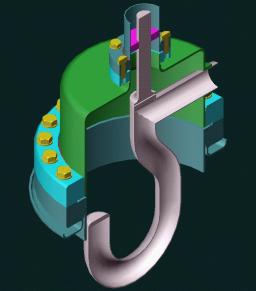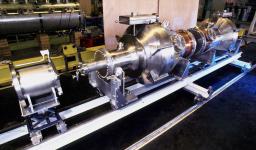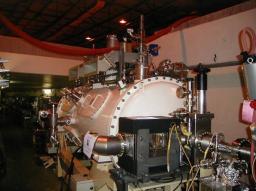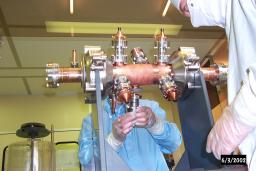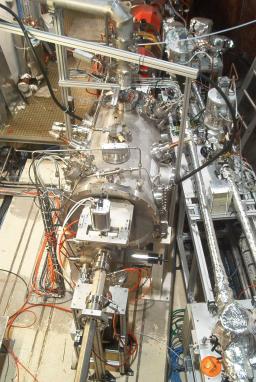• The Soleil cryomodule, placed on the storage ring and which compensates for electromagnetic energy lost in the form of synchrotron radiation. Eventually 650 kW will be continuously transferred from an external power RF source to the beam by power couplers.
• The Super-3HC (Third harmonic superconducting passive cavities) cryomodules that suppress beam instabilities using Landau damping, as well as increasing the beam lifetime. In this case, the power source is the electron beam that transfers a small part of its energy to the cavities.
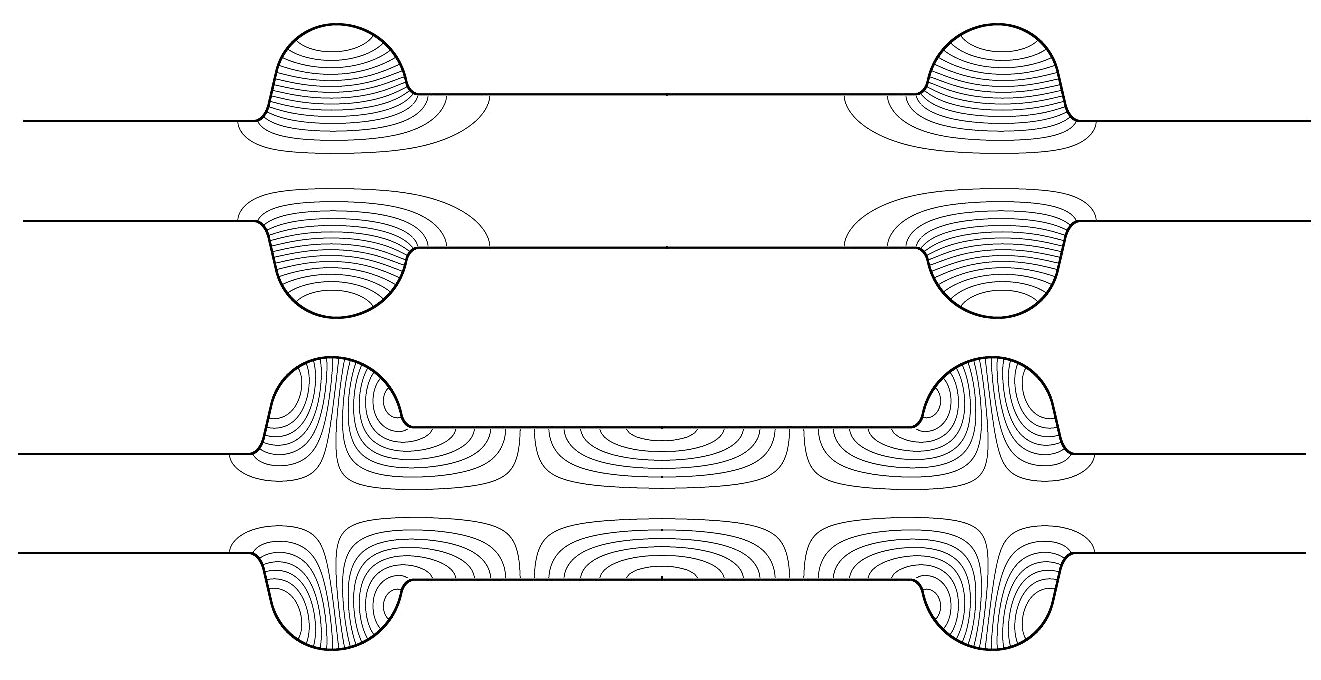
Electric field distribution in the Soleil radio frequency structure for fundamental mode (top drawing) and for HOM mode, the highest order harmonic, (bottom drawing). The couplers, situated at the antinodes of the standing waves vibrating between the two cavities, evacuate the parasite waves to the outside.
Soleil cryomodules
The prototype cryomodule, which operates at 352 MHz and 4.5 K, has been studied and built by SACM in collaboration with CERN during the first detailed design study phase of the Soleil project. The first power tests took place at CERN in December 1999. After that, an agreement was signed with the European Synchrotron Radiation Facility (ESRF) to carry out a series of beam tests on the storage ring at Grenoble, for both cold and room temperature operation modes. This second mode of operation was not planned at the outset; 2001 was given over to preparing the cryomodule so as to fit it for operation at room temperature without effect for the machine users. During testing carried out in 2002 at the ESRF, the Soleil cryomodule generated peak RF voltage of 3 MV for several hours in a stable fashion with a 200 kW power per cavity, thereby contributing to storage of an 180 mA electron current. This performance is sufficient for the first operational year of Soleil in 2005. The decision has therefore been taken that Soleil will be commissioned with this one cryomodule prototype.
Before being installed on the machine, the cryomodule will be upgraded in the framework of a collaboration between CEA, Soleil and CERN. It will be completely dismantled and have its cavities rinsed. In addition, we will install new dipolar HOM couplers to give better fundamental mode rejection, we will modify the internal helium circuit to improve ring cooling on these couplers, we will add a thermal insulation screen to reduce static cryogenic loss, and we will renew all instrumentation. Mechanical studies were sub-contracted out between May and August 2003, and the dismantling operations began in November 2003. Power testing of the renovated cryomodule is planned for December 2004 at CERN.
A second cryomodule of the same design as the first one and incorporating some additional improvements is being developed. It is expected that it will be installed on the machine in 2006.
Before being installed on the machine, the cryomodule will be upgraded in the framework of a collaboration between CEA, Soleil and CERN. It will be completely dismantled and have its cavities rinsed. In addition, we will install new dipolar HOM couplers to give better fundamental mode rejection, we will modify the internal helium circuit to improve ring cooling on these couplers, we will add a thermal insulation screen to reduce static cryogenic loss, and we will renew all instrumentation. Mechanical studies were sub-contracted out between May and August 2003, and the dismantling operations began in November 2003. Power testing of the renovated cryomodule is planned for December 2004 at CERN.
A second cryomodule of the same design as the first one and incorporating some additional improvements is being developed. It is expected that it will be installed on the machine in 2006.
Super-3HC cryomodules
Two harmonic superconducting cavity cryomodules have been developed and built under the aegis of an agreement between CEA, SLS (Swiss Light Source, Paul Scherrer Institut) and ELETTRA (Trieste, Italy). CERN entered this project to undertake fabrication of the two 1.5 GHz copper-niobium cavities. Studies began in 2000. On completion of the construction, assembly and testing phases, the two Super-3HC cryomodules were installed on their respective machines, SLS in June and ELETTRA in August 2002.
Operation of the SLS module has shown its effectiveness on beam stability and life: an increase of a factor of 2.2 has been measured. During 2003 nominal operation of the machine continued with the Super-3HC cavities in action, with no machine stoppages resulting from the cryomodule. Its reliability has therefore been demonstrated.
Introduction of the ELETTRA module was delayed by technical problems in the liquefier; initial cooling was carried out at the beginning of January 2003. During periods at room temperature operation, the only mode of operation possible is high-energy operation (2.4 GeV), since at lower energy (2.0 GeV), the beam becomes unstable due to interaction with the Super-3HC cavities. This problem, which had not been anticipated by ELETTRA, is the major failing of the system, in that it prohibits certain modes of operation in the event of liquefier breakdown. On cold operation on the other hand, activation of the superconducting cavities brings important gains in terms of beam stability and life. Thanks to the Super-3HC cavities, for the first time ELETTRA has been able to deliver a 2.0 GeV-320 mA electron beam free from any instabilities. Increase of the beam lifetime by a factor of 3.5 has been demonstrated.
These harmonic superconducting cavities are the first to be installed successfully on synchrotron radiation machines.

